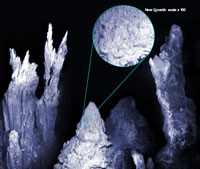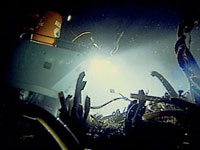 |

For further information, contact the MBL Communications Office at (508) 289-7423 or e-mail us at comm@mbl.edu
For Immediate Release: January 12, 2010
Contact: Diana Kenney, 508-289-7139; dkenney@mbl.edu
 |
 |
 |
Resources

Spectacular, long-lived vents in The Lost City, located 15 km west of the Mid-Atlantic Ridge. Credit: National Science Foundation, with cooperation from the University of Washington. Click for full size.

Video taken at Lost City (2003)
Citation:
Brazelton, W.J., Ludwig, K.A., Sogin, M.L., Andreischeva, E.N., Kelley, D.S., Shen, C.-C., Edwards. R.L., and Baross, J.A. (2009) Archaea and bacteria with surprising microdiversity show shifts in dominance over 1,000-year time scales in hydrothermal chimneys. PNAS Early Edition, week of January 11, 2010.
Links:
Background:
Sogin, M.L., et al. (2006) Microbial diversity in the deep sea and the underexplored “rare biosphere.” PNAS 103, 12115-1212.
|
It’s Their Turn to Shine
Rare Microbes Can Wait Thousands of Years to Flourish, says MBL Scientist
MBL, WOODS HOLE, MA—There is a saying in New England that if you don’t like the weather, just wait a few minutes.
Like hardy Yankees, rare communities of microbes also seem able to wait out unfavorable environmental conditions—even over thousands of years—until conditions shift to spur their growth, according to a study published this week by Mitchell Sogin, director of the MBL’s Bay Paul Center, and colleagues.
The team surveyed the microbes that live in the super-hot chimneys of The Lost City, a deep-sea hydrothermal vent field in the mid-Atlantic Ocean. Some of the Lost City vents were recently born, while others are tens of thousands of years old.
Surprisingly, the team found “minority” microbes that were hardly represented in some of the younger vents had grown to dominate their microbial communities in older vents.
“There were microbial types (taxa) that were low in abundance over many years, and then something changed in terms of weather or rock – we don’t know what – that favored their proliferation,” says Sogin.
"The rare organisms were able to rapidly exploit the new niches as they arose because they had been previously selected for the same conditions in the past," the team wrote in their report, which will appear in this week’s early online edition of Proceedings of the National Academy of Sciences.
Sogin’s laboratory carried out the DNA sequencing and informatics to identify what kinds (taxa) of microbes were present in the Lost City vent samples.
“This study proves that the microbes (we are finding) that are very rare and closely related to the dominant taxa are not artifacts of DNA sequencing,” Sogin says. “The organisms are real, they are capable of growing, and very subtle ecological shifts (in the vents) resulted in them becoming winning populations.”
Sogin first introduced the term “rare biosphere” in 2006 to describe the vast variety of low-abundance microbes found in marine environments, particularly in vent fields. Using a DNA sequencing strategy that found previously undetectable taxa, Sogin and his team showed that bacterial communities in the North Atlantic and in vent fluids in Pacific sea mounts were 10 to 100 times more diverse that
previously thought.
The present study was launched under the aegis of the International Census of Marine Microbes (ICOMM), which is funded by the W.M. Keck Foundation and the Sloan Foundation. William Brazelton and John Baross of the University of Washington are the lead authors. This work was funded by the National Science Foundation, NASA, and the W.M. Keck Foundation.
The MBL is a leading international, independent, nonprofit institution dedicated to discovery and to improving the human condition through creative research and education in the biological, biomedical and environmental sciences. Founded in 1888 as the Marine Biological Laboratory, the MBL is the oldest private marine laboratory in the Americas. For more information, visit www.MBL.edu.
|